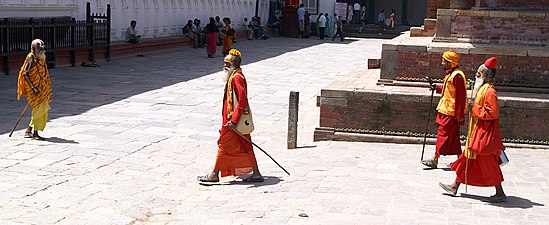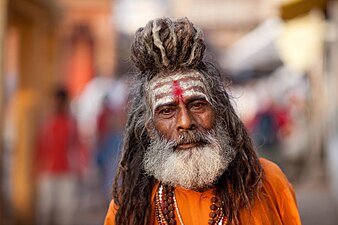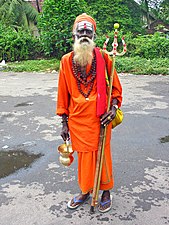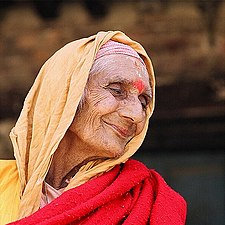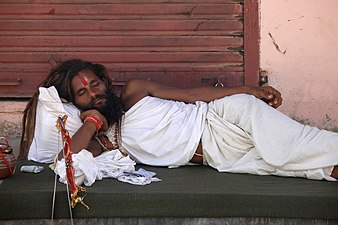Sadhu
| Part of a series on |
| Hinduism |
|---|
 |

Sadhu (
Sādhu means one who practises a '
In Sikhism, a person who has become Brahmgiani is considered a sadhu. However, ascetism, celibacy and begging is prohibited in Sikhism. A Sikh has to be married and do an honest job for a living.[5]
Etymology
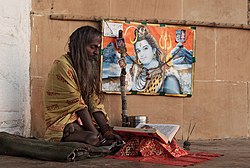
The term sadhu (Sanskrit: साधु) appears in Rigveda and Atharvaveda where it means "straight, right, leading straight to goal", according to Monier Monier-Williams.[6][note 1] In the Brahmanas layer of Vedic literature, the term connotes someone who is "well disposed, kind, willing, effective or efficient, peaceful, secure, good, virtuous, honourable, righteous, noble" depending on the context.[6] In the Hindu Epics, the term implies someone who is a "saint, sage, seer, holy man, virtuous, chaste, honest or right".[6]
The Sanskrit terms sādhu ("good man") and sādhvī ("good woman") refer to renouncers who have chosen to live lives apart from or on the edges of society to focus on their own spiritual practices.[7]
The words come from the root sādh, which means "reach one's goal", "make straight", or "gain power over".[8] The same root is used in the word sādhanā, which means "spiritual practice". It literally means one who practises a ″sadhana″ or a path of spiritual discipline.[4]
Demographics and lifestyle
Unlike skilled workers and professionals, there is no certification for sadhus. So, it is very difficult to determine the exact number of sadhus. According to various assumptions, there are 4 to 5 million sadhus in India today.[citation needed] Sadhus are widely respected for their holiness.[9] It is also thought that the austere practices of the sadhus help to burn off their karma and that of the community at large. Thus seen as benefiting society, sadhus are supported by donations from many people. However, reverence of sadhus is by no means universal in India. For example, Nath yogi sadhus have been viewed with a certain degree of suspicion particularly amongst the urban populations of India, but they have been revered and are popular in rural India.[10][11]
There are naked (digambara, or "sky-clad") sadhus who wear their hair in thick dreadlocks called jata. Sadhus engage in a wide variety of religious practices. Some practice asceticism and solitary meditation, while others prefer group praying, chanting or meditating. They typically live a simple lifestyle, and have very few or no possessions. Many sadhus have rules for alms collection, and do not visit the same place twice on different days to avoid bothering the residents. They generally walk or travel over distant places, homeless, visiting temples and pilgrimage centers as a part of their spiritual practice.[12][13] Celibacy is common, but some sects experiment with consensual tantric sex as a part of their practice. Sex is viewed by them as a transcendence from a personal, intimate act to something impersonal and ascetic.[14]
Sadhu sects


Hinduism
Within the Shaiva sadhus are many subgroups. Most Shaiva sadhus wear a Tripundra mark on their forehead, dress in saffron, red or orange color clothes, and live a monastic life. Some sadhus such as the Aghori share the practices of ancient Kapalikas, where they beg with a skull, smeared their body with ashes from the cremation ground, and experiment with substances or practices that are generally abhorred by society.[15][16]
Among the Shaiva sadhus, the
Female sadhus (sadhvis) exist in many sects. In many cases, the women that take to the life of renunciation are widows, and these types of sadhvis often live secluded lives in ascetic compounds. Sadhvis are sometimes regarded by some as manifestations or forms of the Goddess, or Devi, and are honoured as such. There have been a number of charismatic sadhvis that have risen to fame as religious teachers in contemporary India, e.g. Anandamayi Ma, Sarada Devi, Mata Amritanandamayi, and Karunamayi.[19]
Jainism
The Jain community is traditionally discussed in its texts with four terms: sadhu (monks), sadhvi or aryika (nuns), sravaka (laymen householders) and sravika (laywomen householders). As in Hinduism, the Jain householders support the monastic community.[2] The sadhus and sadhvis are intertwined with the Jain lay society, perform murtipuja (Jina idol worship) and lead festive rituals, and they are organized in a strongly hierarchical monastic structure.[20]
There are differences between the
Becoming a sadhu

The processes and rituals of becoming a sadhu vary with sect; in almost all sects, a sadhu is initiated by a guru, who bestows upon the initiate a new name, as well as a mantra (or sacred sound or phrase), which is generally known only to the sadhu and the guru and may be repeated by the initiate as part of meditative practice.
Becoming a sadhu is a path followed by millions. It is supposed to be the fourth phase in a Hindu's life, after studies, being a father and a pilgrim, but for most it is not a practical option. For a person to become sadhu needs vairagya. Vairagya means desire to achieve something by leaving the world (cutting familial, societal and earthly attachments).[citation needed]
A person who wants to become sadhu must first seek a guru. There, he or she must perform guruseva which means service. The guru decides whether the person is eligible to take sannyasa by observing the sisya (the person who wants to become a sadhu or sanyasi). If the person is eligible, guru upadesa (which means teachings) is done. Only then, the person transforms into sanyasi or sadhu. There are different types of sanyasis in India who follow different sampradya. But, all sadhus have a common goal: attaining moksha (liberation).[citation needed]
Festive gatherings

Gallery
- Sadhu
-
Sadhu in Orchha
-
A sadhu in Kathmandu, Nepal
-
Sadhu in Orchha, Madhya Pradesh
-
Sadhus walking on Durbar Square, Kathmandu
-
Sadhu from Vârânasî
-
Sadhu by the Ghats on the Ganges
-
Sadhus at Kathmandu Durbar Square
-
A sadhu playing flute
-
Sadhu in Varanasi, India.
-
Sadhu at Kaathe Swyambhu, Kathmandu
-
Sadhu in India.
-
Sadhvi or female Sadhu at the Gangasagar Fair transit camp, Kolkata.
-
Sadhu at a river bank
-
Sadhu in Nepal
-
Shiva sadhu in Pushkar, India.
-
Sadhu in Pashupatinath Temple, Kathmandu, Nepal.
-
A female sādhvī in Chanpatia, India, 1906.
-
See also
- Types
- Lineage
- Guru–shishya tradition
- Parampara
- Sampradaya
- Lifestyle
Notes
- ^ See for example:
अग्ने विश्वेभिः स्वनीक देवैरूर्णावन्तं प्रथमः सीद योनिम् । कुलायिनं घृतवन्तं सवित्रे यज्ञं नय यजमानाय साधु ॥१६॥ – Rigveda 6.15.16 (Rigveda Hymn सूक्तं ६.१५, Wikisource)
प्र यज्ञ एतु हेत्वो न सप्तिरुद्यच्छध्वं समनसो घृताचीः । स्तृणीत बर्हिरध्वराय साधूर्ध्वा शोचींषि देवयून्यस्थुः ॥२॥ – Rigveda 7.43.2 (Rigveda Hymn सूक्तं ७.४३, Wikisource)
यथाहान्यनुपूर्वं भवन्ति यथ ऋतव ऋतुभिर्यन्ति साधु । यथा न पूर्वमपरो जहात्येवा धातरायूंषि कल्पयैषाम् ॥५॥ – Rigveda 10.18.5 (Rigveda Hymn सूक्तं १०.१८, Wikisource), etc.
References
- ^ a b c "sadhu and swami | Hindu ascetic | Britannica". www.britannica.com.
- ^ a b c Jaini 1991, p. xxviii, 180.
- ^ ISBN 978-0-7914-7082-4.
- ^ a b ″Autobiography of an Yogi″, Yogananda, Paramhamsa, Jaico Publishing House, 127, Mahatma Gandhi Road, Bombay Fort Road, Bombay (Mumbai) - 400 0023 (ed.1997) p.16
- ^ Winternitz, M., History of Indian Literature. Tr. S. Ketkar. Calcutta, 1927
- ^ a b c Sadhu, Monier Williams Sanskrit English Dictionary with Etymology, Oxford University Press, page 1201
- ISBN 0-521-43878-0
- ^ Arthur Anthony Macdonell. A Practical Sanskrit Dictionary. p. 346.
- ^ Dolf Hartsuiker. Sadhus and Yogis of India Archived 15 October 2007 at the Wayback Machine.
- ^ White, David Gordon (2012), The Alchemical Body: Siddha Traditions in Medieval India, University of Chicago Press, pp. 7–8
- ISBN 978-1438438900, pages x-xi
- ISBN 978-0791459225, pages 24-29
- ISBN 978-9042015104, pages 97-98
- ISBN 978-0521604017, Chapter 4 with pages 105-107 in particular
- ISBN 978-0-470-99868-7
- ISBN 978-0-520-01842-6
- ^ 1953: 116; cf. also Farquhar 1925; J. Ghose 1930; Lorenzen 1978
- ^ "The Wrestler's Body". Publishing.cdlib.org. Retrieved 29 March 2012.
- ^ "Home - Amma Sri Karunamayi". Retrieved 20 April 2015.
- ^ JSTOR 2803774.
- ISBN 978-0-7618-4762-5.
- New York Times. Retrieved 24 November 2010.
- ^ Pandey, Geeta (14 January 2013). "Kumbh Mela: 'Eight million' bathers on first day of festival". BBC News.
Further reading
- ISBN 0-520-06820-3
- Indian Sadhus, by Govind Sadashiv Ghurye, L. N. Chapekar. Published by Popular Prakashan, 1964.
- Sadhus of India: The Sociological View, by Bansi Dhar Tripathi. Published by Popular Prakashan, 1978.
- The Sadhu: A Study in Mysticism and Practical Religion, by Burnett Hillman Streeter, Aiyadurai Jesudasen Appasamy. Published by Mittal, 1987. ISBN 0-8364-2097-7.
- The Way of the Vaishnava Sages: A Medieval Story of South Indian Sadhus : Based on the Sanskrit Notes of Vishnu-Vijay Swami, by N. S. Narasimha, Rāmānanda, Vishnu-Vijay. Published by University Press of America, 1987. ISBN 0-8191-6061-X.
- Sadhus: The Holy Men of India, by Rajesh Bedi. Published by Entourage Pub, 1993. ISBN 81-7107-021-3.
- Sadhus: Holy Men of India, by Dolf Hartsuiker. Published by Thames & Hudson, 1993. ISBN 0-500-27735-4.
- The Sadhus and Indian Civilisation, by Vijay Prakash Sharma. Published by Anmol Publications PVT. LTD., 1998. ISBN 81-261-0108-3.
- Women in Ochre Robes: Gendering Hindu Renunciation, by Meena Khandelwal. Published by State University of New York Press, 2003. ISBN 0-7914-5922-5.
- Wandering with Sadhus: Ascetics in the Hindu Himalayas, Sondra L. Hausner, Bloomington, Indiana University Press, 2007. ISBN 978-0-253-21949-7
- Naked in Ashes, Paradise Filmworks International – Documentary on Naga Sadhus of Northern India.
External links
- Sadhus and Yogis of India
- "Sadhus from India"—Extract from The Last Free Men by José Manuel Novoa
- "Interview of a Sadhu Living Inside a Cave in the Himalayas"—Episode from Ganga Ma: A Pilgrimage to the Source by Pepe Ozan and Melitta Tchaicovsky




